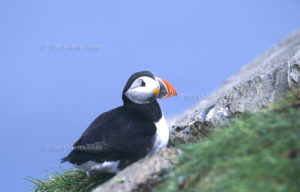 It is cool and cloudy when I am in Martin’s Haven in the morning. This is where the ferries leave for Skomer Island.
It is cool and cloudy when I am in Martin’s Haven in the morning. This is where the ferries leave for Skomer Island.
The boat to Skomer Island departs from Martin’s Haven, a small bay that can be reached by car in a few minutes from Marloes in western Wales. The ferry will normally transfer to Skomer Island at 10:00 am, 11:00 am and 12:00 am. There are about 40 people on the boat. Therefore, the number of visitors is limited to about 120 per day. My pension owner said that the rush can be very large and you should be there 1 hour before the ticket sale begins. On that day, however, the rush was not so great because the weather was not very good. When I arrived there shortly after 8:00 am, I was actually the first one, but soon some people arrived. It was still not clear if the ferry would go at all. At some point, the ticket sales were then unlocked, but on demand we were only told that is not decided whether the ferry leaves or whether the captain will decide on the spot. The captain would not arrive until 9:00 am.
There were more and more people, but fortunately I was in the lead in the queue and did not have to worry about not getting a ticket if the ferry only went once this time. After a long, anxious wait, the captain finally arrived and decided that the ferry would leave. It was a bit of a miracle for me as it stormed just like the days before and the weather forecast also announced a storm for the rest of the week and I was not very confident to get to Skomer Island at all.
The ferry is quite small and I did not think that actually 40 people fit on it and it got pretty tight, especially since a lot of the people had big backpacks with photo equipment. The crossing takes about 20 minutes, and the waves, which looked rather harmless from the land, showed significantly larger when on the ship. It reminded me very much of the crossing to Handa in Scotland. There, too, you had to leave the small fishing port of Tarbet in County Lairg in the Scottish Highlands, and then land after a short crossing on the bird island of Handa.
Arriving on Skomer Island, first you had to climb up a steep staircase. Next to the stairs you could already see the first Atlantic Puffins (Fratercula arctica) and the photographers of course immediately unpacked their cameras and lenses and began to take photos. Unfortunately the first show was over after a few seconds. First there was a small introductory lecture about the island and how to behave on the island, which ways to use and where to find which birds.
The best place to photograph puffins is “The Wick” in the south of the island. Of course, the photographers immediately set off to this site. And indeed, a lot of puffins breed there, and they are not afraid of people. For me it was certainly one of my best experiences to be able to photograph the cute birds at close range.
There I have experienced that the Atlantic Puffins came again and again under the shortest distance of my lens (Canon 4.0 / 400 DO). At the same time the puffins approached; I do not care about them. Breeding was already under way on Skomer, but the chicks had not yet hatched. Thus, I had seen only a single puffin on the beak full of sandeels (Ammodytes sp.). You get really close to the puffins or they approach the photographer very close, so I took a lot of pictures also with the wideangle lens as well. I frequently use the Canon 400 DO II for excursions abroad with the 1.4 converter on a Canon 1 DX or a Canon EOS 5 DsR.
The visit time on the island is limited by the boat times. The places in the self-supply huts are booked long in advance, usually already in the previous year. Puffins are often seen standing in more or less large groups on rocky outcroppings. If you devote yourself to this bird for a while, you see a puffin after the other flying in a bumble-bee-like flight and then happily joining its conspecifics.
To cope with the growing demand for top shots of the rarer species of the Palearctic Bird-Lens is keen to enrich the range of pictures of birds you can find in the western palearctic. Trips to remote places to capture images not only of rare birds of western palearctic were very successful. The nice image of the blog is only a first impression, what you will find in the gallery in the “Picture Shop” very soon. Just give bird-lens.com a message, if bird-lens.com could serve you with an image needed before the new pictures are online.